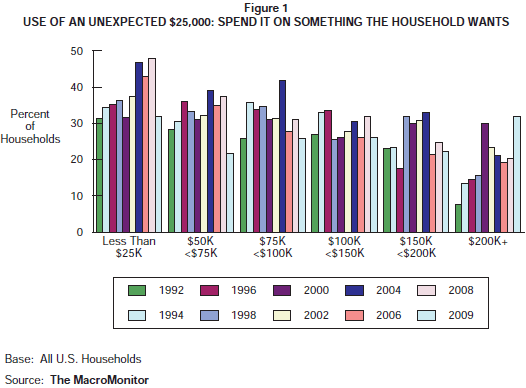What If the Wealthy Stop Spending? August 2010
Recently, a New York Times article made the point that the 2009 economic recovery was primarily due to affluent households' overcoming the uncertainty that others felt and coming back to spending. However, in 2010, the recovery has lost momentum, and some people believe that that loss is because the wealthy have slowed down their spending. The top 5% of consumers account for a disproportionately large amount of consumer spending, especially for nonessentials—sometimes as much as a third of all outlays. Consumer Financial Decisions' MacroMonitor reveals a trend of households that would spend a $25 000 windfall on something the household wants and provides supporting evidence that the wealthy were key to supporting the recovery.

The trend by annual household income indicates a pattern for households making less than $100 000: Spending went up throughout the 1990s. This same pattern is evident for households with $200 000 or more in income. However, once we cross Y2K, the spending pattern becomes more erratic: Households with less than $75 000 in annual income become more likely to say that they would spend this windfall, and households with $150 000 or more say that they are less likely to do so. The pattern for households between $75 000 and $150 000 tends to jump up and down.
What is particularly interesting and revealing is what happens between 2008 and 2009. When the same households that we interviewed in the spring and summer of 2008—before the fall—answered the same $25 000 windfall question in February 2009, fewer households from every income range said that they would spend it (significant for households with incomes of less than $75 000). The exception was households making $200 000 or more. Significantly more of these households say that they would spend this windfall than said so when they were interviewed a year before.
Having higher incomes and being willing to spend them right at the bottom of the market decline may be the height of contrarian behavior. However, since the market nadir, many signs—continued unemployment, lower consumer confidence, increased market volatility—have indicated that the economy is not roaring back to full health. If, as the New York Times article suggests, the wealthy have pulled back their spending, then unless other segments begin to spend more (and few have the resources to do so), this recovery may be on hold. When the 2010–11 MacroMonitor data become available this fall, we will have critical additional evidence about the state of spending among the wealthy, the mass affluent, and the mass markets.